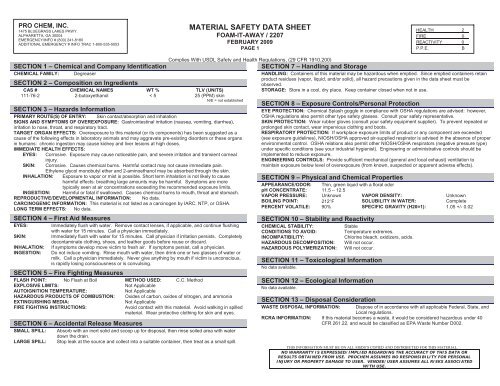Print MSDS - Miller Electric Company Publications
Print MSDS - Miller Electric Company Publications
Print MSDS - Miller Electric Company Publications
Create successful ePaper yourself
Turn your PDF publications into a flip-book with our unique Google optimized e-Paper software.
PRO CHEM, INC.<br />
1475 BLUEGRASS LAKES PKWY.<br />
ALPHARETTA, GA 30004<br />
EMERGENCY/INFO # (800) 241-8180<br />
ADDITIONAL EMERGENCY # INFO TRAC 1-800-535-5053<br />
SECTION 1 – Chemical and <strong>Company</strong> Identification<br />
CHEMICAL FAMILY: Degreaser<br />
SECTION 2 – Composition on Ingredients<br />
CAS # CHEMICAL NAMES WT % TLV (UNITS)<br />
111-76-2 2-butoxyethanol < 5 25 (PPM) skin<br />
N/E = not established<br />
SECTION 3 – Hazards Information<br />
PRIMARY ROUTE(S) OF ENTRY: Skin contact/absorption and inhalation<br />
SIGNS AND SYMPTOMS OF OVEREXPOSURE: Gastrointestinal irritation (nausea, vomiting, diarrhea),<br />
irritation to nose, throat, and respiratory tract.<br />
TARGET ORGAN EFFECTS: Overexposure to this material (or its components) has been suggested as a<br />
cause of the following effects in laboratory animals and may aggravate pre-existing disorders or these organs<br />
in humans: chronic ingestion may cause kidney and liver lesions at high doses.<br />
IMMEDIATE HEALTH EFFECTS:<br />
EYES: Corrosive. Exposure may cause noticeable pain, and severe irritation and transient corneal<br />
injury.<br />
SKIN: Corrosive. Causes chemical burns. Harmful contact may not cause immediate pain.<br />
Ethylene glycol monobutyl ether and 2-aminoethanol may be absorbed through the skin.<br />
INHALATION: Exposure to vapor or mist is possible. Short term inhalation is not likely to cause<br />
harmful effects: breathing large amounts may be harmful. Symptoms are more<br />
typically seen at air concentrations exceeding the recommended exposure limits.<br />
INGESTION: Harmful or fatal if swallowed. Causes chemical burns to mouth, throat and stomach.<br />
REPRODUCTIVE/DEVELOPMENTAL INFORMATION: No data.<br />
CARCINOGENIC INFORMATION: This material is not listed as a carcinogen by IARC, NTP, or OSHA.<br />
LONG TERM EFFECTS: No data.<br />
SECTION 4 – First Aid Measures<br />
EYES: Immediately flush with water. Remove contact lenses, if applicable, and continue flushing<br />
with water for 15 minutes. Call a physician immediately.<br />
SKIN: Immediately flush with water for 15 minutes. Call physician if irritation persists. Completely<br />
decontaminate clothing, shoes, and leather goods before reuse or discard.<br />
INHALATION: If symptoms develop move victim to fresh air. If symptoms persist, call a physician.<br />
INGESTION: Do not induce vomiting. Rinse mouth with water, then drink one or two glasses of water or<br />
milk. Call a physician immediately. Never give anything by mouth if victim is unconscious,<br />
is rapidly losing consciousness or is convulsing.<br />
SECTION 5 – Fire Fighting Measures<br />
FLASH POINT: No Flash at Boil METHOD USED: C.C. Method<br />
EXPLOSIVE LIMITS: Not Applicable<br />
AUTOIGNITION TEMPERATURE: Not Applicable<br />
HAZARDOUS PRODUCTS OF COMBUSTION: Oxides of carbon, oxides of nitrogen, and ammonia<br />
EXTINGUISHING MEDIA: Not Applicable<br />
FIRE FIGHTING INSTRUCTIONS: Avoid contact with this material. Avoid walking in spilled<br />
material. Wear protective clothing for skin and eyes.<br />
SECTION 6 – Accidental Release Measures<br />
SMALL SPILL: Absorb with an inert solid and scoop up for disposal, then rinse soiled area with water<br />
down the drain.<br />
LARGE SPILL: Stop leak at the source and collect into a suitable container, then treat as a small spill.<br />
MATERIAL SAFETY DATA SHEET<br />
FOAM-IT-AWAY / 2207<br />
FEBRUARY 2009<br />
PAGE 1<br />
Complies With USDL Safety and Health Regulations, (29 CFR 1910.200)<br />
HEALTH 2<br />
FIRE 0<br />
REACTIVITY 0<br />
P.P.E. B<br />
SECTION 7 – Handling and Storage<br />
HANDLING: Containers of this material may be hazardous when emptied. Since emptied containers retain<br />
product residues (vapor, liquid, and/or solid), all hazard precautions given in the data sheet must be<br />
observed.<br />
STORAGE: Store in a cool, dry place. Keep container closed when not in use.<br />
SECTION 8 – Exposure Controls/Personal Protection<br />
EYE PROTECTION: Chemical Splash goggle in compliance with OSHA regulations are advised: however,<br />
OSHA regulations also permit other type safety glasses. Consult your safety representative.<br />
SKIN PROTECTION: Wear rubber gloves (consult your safety equipment supplier). To prevent repeated or<br />
prolonged skin contact, wear impervious clothing and boots.<br />
RESPIRATORY PROTECTION: If workplace exposure limits of product or any component are exceeded<br />
(see exposure guidelines), NIOSH/OSHA approved air-supplied respirator is advised in the absence of proper<br />
environmental control. OSHA relations also permit other NIOSH/OSHA respirators (negative pressure type)<br />
under specific conditions (see your industrial hygienist). Engineering or administrative controls should be<br />
implemented to reduce exposure.<br />
ENGINEERING CONTROLS: Provide sufficient mechanical (general and local exhaust) ventilation to<br />
maintain exposure below level of overexposure (from known, suspected or apparent adverse effects).<br />
SECTION 9 – Physical and Chemical Properties<br />
APPEARANCE/ODOR: Thin, green liquid with a floral odor<br />
pH CONCENTRATE: 11.5 – 12.5<br />
VAPOR PRESSURE: Unknown VAPOR DENSITY: Unknown<br />
BOILING POINT: 212F SOLUBILITY IN WATER: Complete<br />
PERCENT VOLATILE: 90% SPECIFIC GRAVITY (H20=1): 1.05 +/- 0.02<br />
SECTION 10 – Stability and Reactivity<br />
CHEMICAL STABILITY: Stable<br />
CONDITIONS TO AVOID: Temperature extremes.<br />
INCOMPATIBILITY: Chlorine bleach, oxidizers, acids.<br />
HAZARDOUS DECOMPOSITION: Will not occur.<br />
HAZARDOUS POLYMERIZATION: Will not occur.<br />
SECTION 11 – Toxicological Information<br />
No data available.<br />
SECTION 12 – Ecological Information<br />
No data available.<br />
SECTION 13 – Disposal Consideration<br />
WASTE DISPOSAL INFORMATION: Dispose of in accordance with all applicable Federal, State, and<br />
Local regulations.<br />
RCRA INFORMATION: If this material becomes a waste, it would be considered hazardous under 40<br />
CFR 261.22, and would be classified as EPA Waste Number D002.<br />
THIS INFORMATION MUST BE ON ALL <strong>MSDS</strong>’S COPIED AND DISTRIBUTED FOR THIS MATERIAL.<br />
NO WARRANTY IS EXPRESSED/IMPLIED REGARDING THE ACCURACY OF THIS DATA OR<br />
RESULTS OBTAINED FROM USE. PROCHEM ASSUMES NO RESPONSIBILITY FOR PERSONAL<br />
INJURY OR PROPERTY DAMAGE TO USER. VENDEE/USER ASSUMES ALL RISKS ASSOCIATED<br />
WITH USE.



